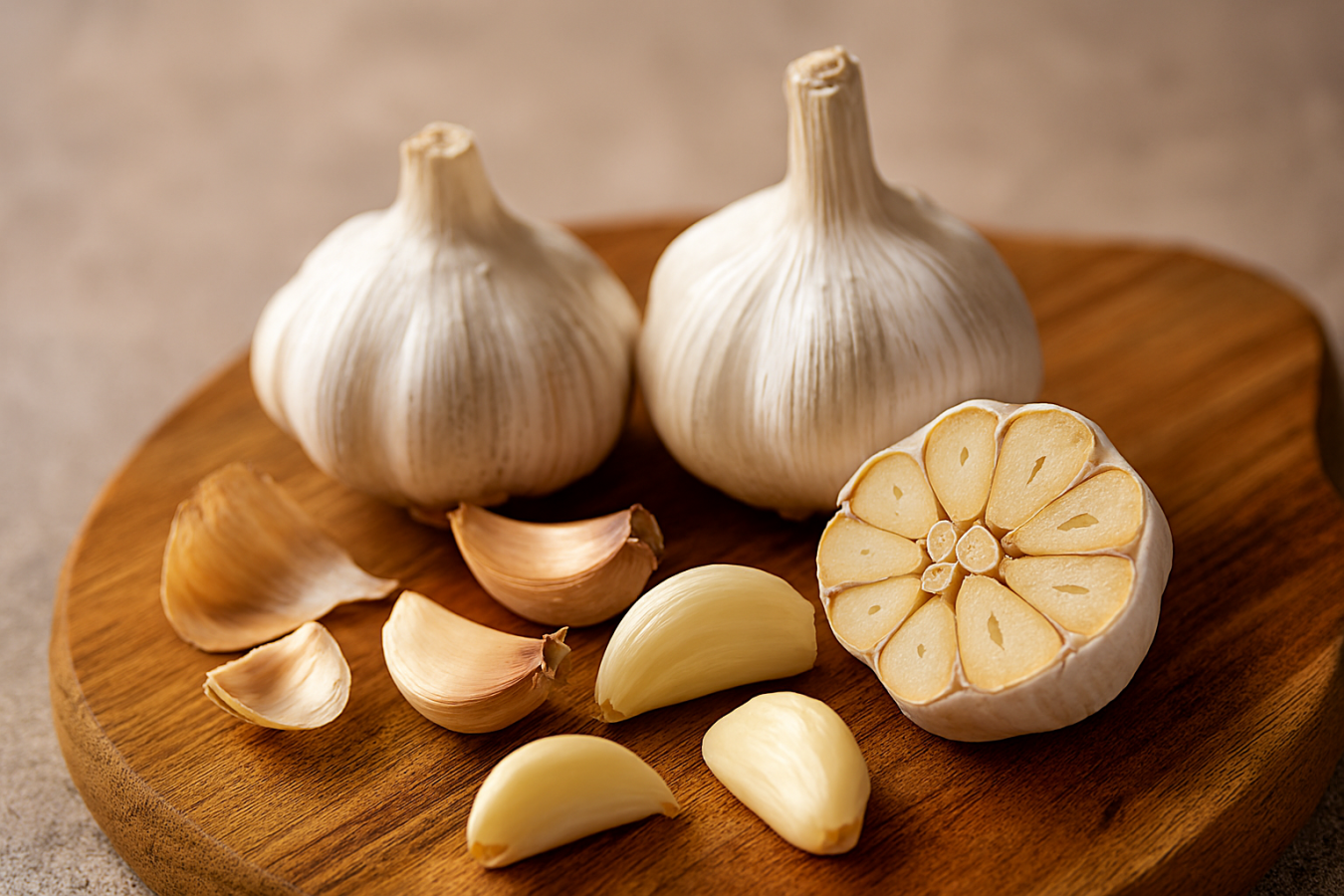Garlic is more than flavor—it’s a practical staple with nutrition, versatility, and a few smart handling techniques that make it shine. This guide keeps it simple and actionable, from choosing bulbs to quick recipes and safety notes.
Table of contents
Quick facts
- What it is: A pungent allium (Allium sativum) related to onions, leeks, and chives.
- Main flavor note: Savory, sulfurous, and aromatic; sweet and mellow when roasted.
- Key compound: Allicin, formed when garlic is crushed or chopped, contributing to aroma and potential benefits.
- Best use: Add near the middle or end of cooking to avoid bitterness; roast for a soft, spreadable sweetness.
- Storage: Keep whole bulbs cool, dry, and ventilated; avoid refrigerating whole heads.
Nutrition and active compounds
Core nutrition (per ~3g clove)
- Calories: ~4
- Carbs: ~1g
- Fiber: Minimal
- Micronutrients: Small amounts of vitamin C, B6, manganese, and selenium.
Bioactive compounds
- Allicin: Forms after cutting/crushing; heat reduces it, but flavor remains.
- Sulfur compounds: Diallyl disulfide, S-allyl cysteine and others contribute aroma and research interest.
- Antioxidants: Various compounds may help counter oxidative processes.
Tip: For maximum allicin, crush or mince and let rest ~10 minutes before heating.
Potential health benefits
Garlic has been studied for several areas. It’s useful as part of a balanced diet, but it’s not a standalone treatment.
- Heart health: Diets including garlic may support healthy lipid profiles and blood pressure when combined with broader lifestyle changes.
- Immune support: Bioactive compounds can complement normal immune function; garlic does not replace medical care.
- Antioxidant support: Sulfur compounds and antioxidants may help reduce oxidative stress.
- Gut-friendly flavor: Widely tolerated in cooked forms; raw can be intense for sensitive stomachs.
Reminder: If you have medical conditions or take medications (e.g., anticoagulants), discuss garlic intake with a healthcare professional.
Buying and varieties
- Selecting bulbs: Choose firm, heavy heads with tight, un-sprouted skins. Avoid soft spots or moisture.
- Common types: Softneck (longer storage, milder) and hardneck (often more complex flavor, easier to peel).
- Fresh vs. pre-minced: Fresh cloves give brighter flavor; jarred is convenient but often milder.
- Black garlic: A slow-fermented product with sweet, balsamic notes and jammy texture.
Preparation and cooking tips
Peeling and cutting
- Smash to peel: Lightly crush a clove with the flat knife side to loosen the skin.
- Mince vs. slice: Finer cuts mean stronger, faster flavor; slices stay milder.
- Microplane: Grating creates a paste for dressings and sauces.
Cooking essentials
- Avoid burning: Garlic browns quickly. Cook over medium heat and add later in the process.
- Roasting: Cut top off a bulb, drizzle oil, wrap, and roast at ~400°F (205°C) for 35–45 minutes until soft.
- Blooming: Gently warm sliced garlic in oil to infuse flavor, then build the dish.
Flavor control: Add raw for punch; add early for mellow background; roast for sweet spreadability.
Storage and shelf life
- Whole bulbs: Store in a breathable basket in a cool, dry place. Avoid sealed plastic bags.
- Peeled cloves: Refrigerate in a sealed container and use within 1 week.
- Chopped/minced: Refrigerate tightly sealed and use within 2–3 days.
- Freezing: Freeze whole peeled cloves or garlic paste; expect texture changes but good flavor retention.
- Oil infusions: Refrigerate promptly and use within a few days; do not store garlic-in-oil at room temperature.
Safety, interactions, and considerations
- Medication interactions: Garlic may interact with blood thinners and affect bleeding risk. Consult a professional if relevant.
- Digestive sensitivity: Raw garlic can irritate; start with small amounts or cook thoroughly.
- Allergies: Rare but possible. Stop use and seek care if reactions occur.
- Botulism risk: Garlic-in-oil at room temperature can be unsafe. Keep refrigerated and use quickly.
- Supplements: Potencies vary widely. Food-first approaches are generally safer for everyday use.
Quick recipe ideas
- Garlic butter toast: Mix softened butter, minced garlic, pinch of salt, and parsley; spread and broil until golden.
- 10-minute garlic greens: Sauté sliced garlic in olive oil; add spinach or kale, salt, lemon, and pepper.
- Roasted garlic mash: Blend roasted cloves into mashed potatoes with olive oil and chives.
- Garlic yogurt dip: Combine Greek yogurt, grated garlic, salt, dill, and lemon; serve with veggies.
- Infused oil finish: Gently warm sliced garlic in oil; drizzle over soups, grains, or roasted vegetables.
Common myths, clarified
- Garlic cures colds: It can be part of supportive nutrition, but it does not cure infections.
- More garlic is always better: Flavor peaks before bitterness; large raw amounts can upset digestion.
- Jarred is inferior: It’s convenient and safe when handled properly, just expect milder flavor.
- Refrigerating bulbs extends life: Whole bulbs do better in cool, dry air; fridge humidity can promote sprouting.
FAQs
How do I reduce garlic breath?
Pair meals with parsley, yogurt, or apples; chew fresh herbs; and avoid large amounts of raw garlic. Good oral hygiene helps.
Is sprouted garlic safe to eat?
Yes, it’s generally safe. The flavor can be sharper or slightly bitter; remove any green shoot if desired.
Can I substitute garlic powder for fresh?
Yes. Garlic powder is concentrated and convenient. Start with 1/4 teaspoon per clove equivalent and adjust to taste.
What’s the difference between softneck and hardneck?
Softneck stores longer and is often milder; hardneck can have larger cloves and more nuanced flavor.

